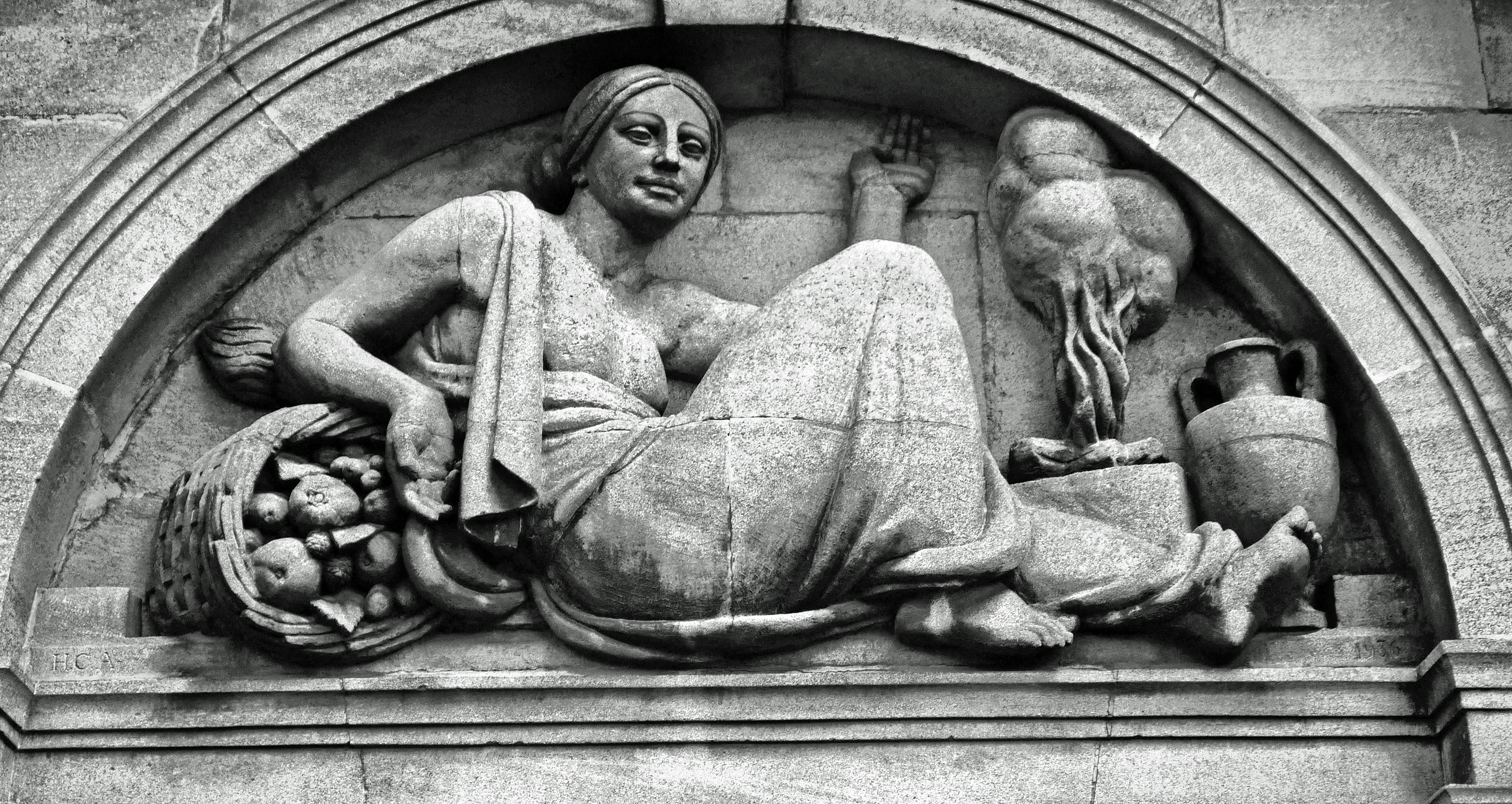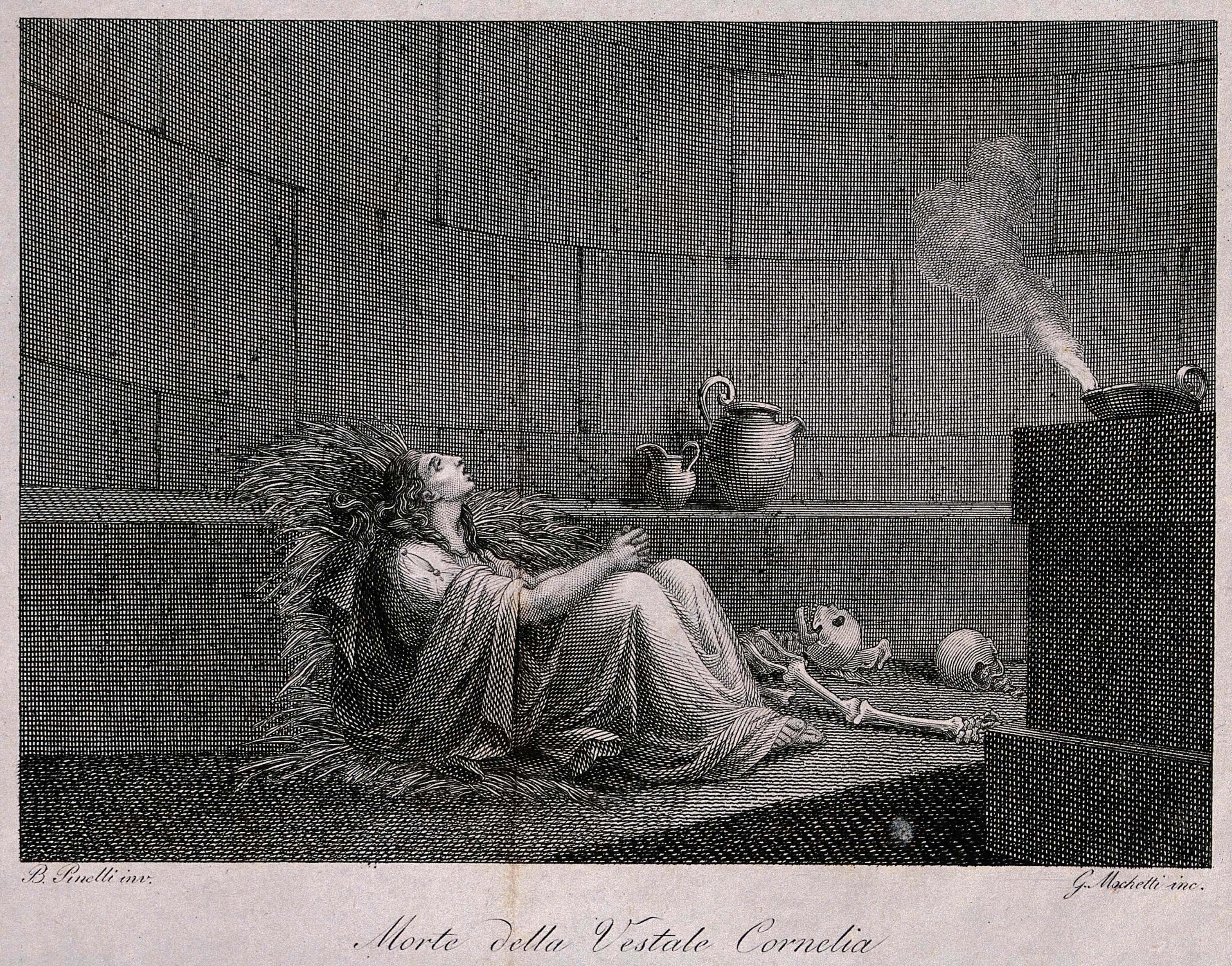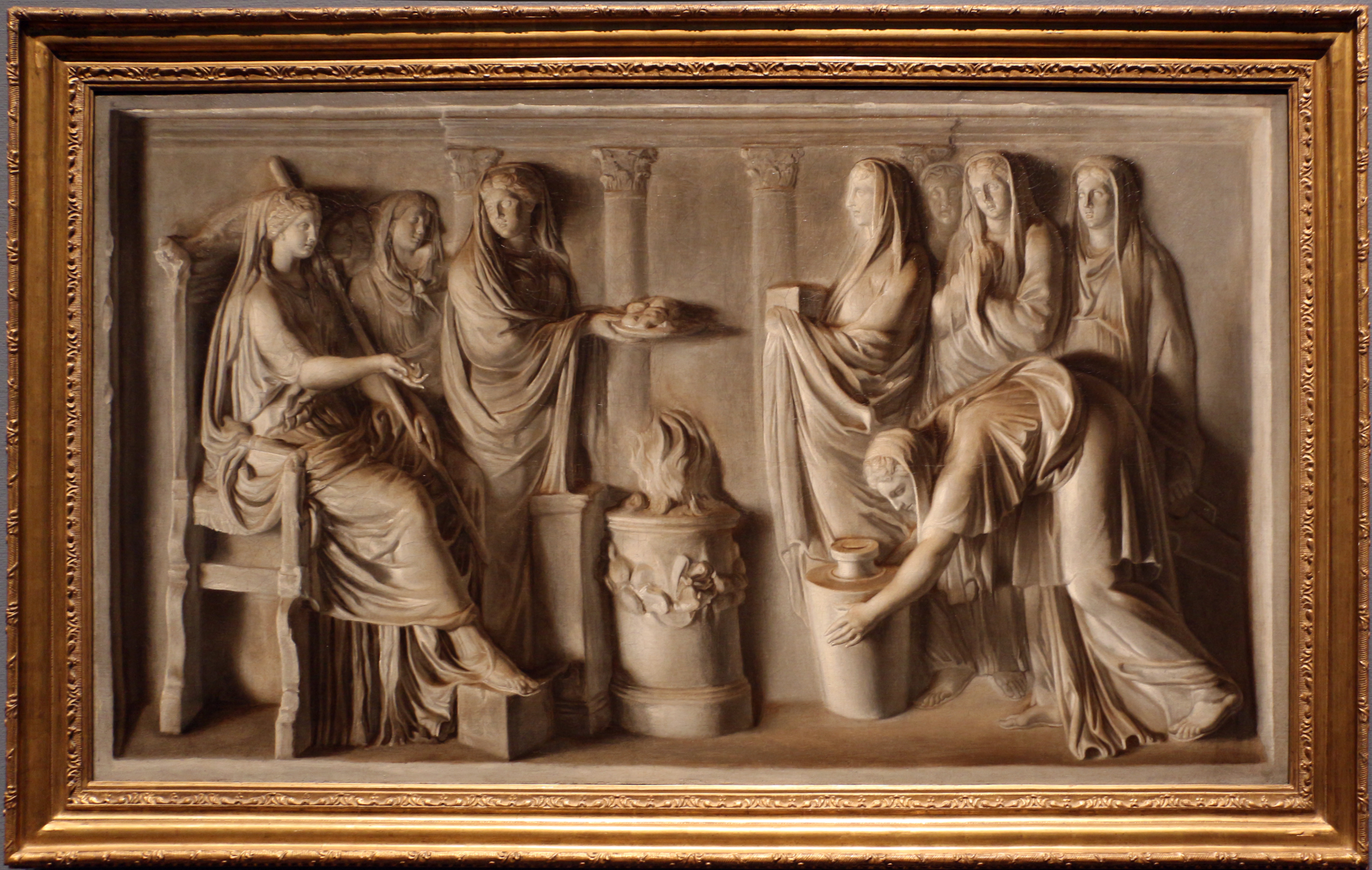The Vestal Virgins were one of the most fascinating and enigmatic among the religious groups in Ancient Rome. They were entrusted with the sacred task of maintaining the eternal flame in the temple of Vesta and performing numerous rituals that were integral to Roman religion and society.
They were selected as young girls and served for a duration of thirty years. During this time, they were expected to remain chaste and dedicated to their priestly duties. The significance of their role was reflected in the privileges they enjoyed, including legal independence and a level of influence in Roman affairs not commonly allowed to women of that era.

Their commitment to chastity and the consequences of breaking this vow were severe. It reflected the seriousness of how Roman society viewed the Vestal Virgins’ responsibilities. They symbolized the purity of the city and were thought to be essential for the security and stability of Rome.
Over time, the Vestal Virgins amassed considerable prestige and had significant political and social influence. They participated in rituals that ranged from public ceremonies to secretive rituals. Their lifestyle, living conditions, and the historical context in which they lived paint a vivid picture of their importance in the fabric of Roman life.
Key Takeaways
- The Vestal Virgins held a pivotal position in maintaining religious customs and upholding the morals of Ancient Rome.
- They were granted exceptional privileges, indicating their substantial civic influence and societal importance.
- The complexity of their roles and the severity of the consequences they faced for misconduct highlight the critical nature of their existence in the ancient city.
Historical Context
The Vestal Virgins were central to the religious and civic life of ancient Rome. They symbolized the city’s safety and prosperity through their sacred duties. Their existence spans from the earliest days of the Roman Kingdom to the decreasing years of the late Roman Empire, adapting roles and significance throughout Roman history.

Origins of the Vestal Virgins
The Vestal Virgins were traditionally attributed to Numa Pompilius (ruled 714-673 BC), the second king of Rome in the early 7th century BC. These priestesses were appointed to serve Vesta, the goddess of the hearth, and were tasked with maintaining the sacred fire within the Roman Forum, a representation of Rome’s eternal life.
The creation of the Vestals was a pivotal step in structuring the Roman state cult, positioning them as integral in preserving the religious customs that underpin Roman society.
Evolution Through Roman History
The role of Vestal Virgins evolved significantly throughout the Roman Republic and the Roman Empire. Initially, they were guardians of divine will within the Roman Forum. However, as Rome’s political system transformed, so did the Vestals’ position within society.
During the Republic, they were granted privileges and immunities, reflecting their esteemed status within the Roman state. As the Empire ascended, their presence symbolized the continuity and traditional values of Rome, through rapid expansion and social change.
Their dissolution in the 4th century AD by Emperor Theodosius marked the end of an era for Roman religion and was symbolic of the Empire’s shift away from its polytheistic origins to Christianity.
What Did The Vestal Virgins Do?
Selection Process
From a young age, girls were chosen to become Vestal Virgins based on specific criteria such as nobility of birth, physical and mental health, and proof of innocence. They were selected through a rigorous and sacred ceremony, accepting the obligation that required them to remain virgins dedicated to Vesta, for at least 30 years.
Vow of Chastity and Duties
A Vestal Virgin’s primary obligation was to maintain her chastity and perform religious rituals. This vow of chastity symbolized a marriage to Rome and the goddess Vesta. They were also responsible for safeguarding sacred objects and keeping the eternal flame alight.
Privileges
Vestal Virgins enjoyed numerous privileges, including prime seating at public events, personal bodyguards, and the ability to manage their own finances.
Punishments for Transgressions
Should a Vestal Virgin break her vow of chastity, she faced severe punishment, with the most infamous being buried alive. This grave sentence showed the societal value placed on their purity and the perceived severity of such a transgression.
Religious Roles and Rituals
The Vestal Virgins served crucial functions within ancient Roman religion, focusing on safeguarding the sacred flame and performing assorted rituals and ceremonies. They were highly visible during various festivals, embodying the city’s religious commitments.
Keeper of the Sacred Flame
The primary duty of the Vestal Virgins was to maintain the sacred flame within the Temple of Vesta. They ensured this symbol of the eternal vitality of Rome, believed to be tied to the city’s fortune, never extinguished. The hearth in the Temple of Vesta was more than a mere fire; it was a manifestation of the goddess Vesta herself, protector of the home and hearth.
Rituals and Ceremonies
The Vestal Virgins performed numerous rituals and ceremonies, which often involved the preparation of ritual foods like mola salsa, a sacred mixture used in offerings.
Their functions extended to various domains, such as presiding over the preparation and tending to sacrifices made to Vesta, the goddess of the hearth. These priestesses were also tasked with guarding sacred objects and performing rituals central to Roman culture and religion.
Festivals and Public Appearances
The Vestal Virgins were at the forefront during the Vestalia, an annual festival in honor of Vesta. This public event allowed the otherwise secluded priestesses to partake actively in celebrations, including games and public rituals.
Their presence was pivotal, highlighting their esteemed roles in Roman society. As embodiments of the city and its religious ethos, these public appearances reinforced their importance to the state’s spiritual well-being.
Civic Duties and Influence

The Vestal Virgins held a unique position within Roman society, responsible for safeguarding a variety of sacred objects and exercising considerable influence over legal and political matters—particularly in their roles as guardians of wills and property.
Guardians of Sacred Objects and Wills
Within the House of the Vestals, also known as the Atrium Vestae, these priestesses were charged with the protection of sacred relics critical to the religious and social fabric of the Roman state.
They were also entrusted with the safekeeping of wills, a responsibility that granted them significant influence in Roman society. Their role extended to the preservation and management of property, including being able to own property in their own right, a privilege not commonly afforded to women at the time.
Roles in Politics and Community
The Vestal Virgins had an esteemed social status that transcended the typical boundaries of female roles in Roman society.
Due to their unique position, they could intervene in political processes, such as the liberation of slaves and the adjournment of military operations. The community held them in high regard, and their presence at public events signified the favor of the gods upon the Roman people.
Lifestyle and Living Conditions

The Vestal Virgins led a life marked by rigor and privilege, serving as priestesses in the House of the Vestal Virgins. Tasked with maintaining the sacred fire of Vesta, their daily activities and living spaces were a reflection of their vital role in Roman society and religion.
Daily Life of a Vestal Virgin
The daily schedule of a Vestal Virgin was a harmonious blend of public duties and private discipline.
Each day, they were responsible for tending the sacred fire of Vesta, performing various religious rituals, and participating in numerous civic events. Their unique position in society granted them access to events typically reserved for men, and they held a certain level of influence over public affairs.
Accommodation and Attires
Accommodation: The Vestal Virgins resided in the House of the Vestal Virgins, a spacious and prominently located villa near the Roman Forum. This complex not only served as living quarters but also as a ceremonial space, uniquely combining public and private spheres.
Attires: The Vestal Virgins were recognized by their distinctive clothing, which symbolized their purity and status. The stola, a long, pleated dress, was worn beneath the suffibulum, a white woolen veil. They also adorned the infula, woolen bands, that hung from their elaborate hairstyles, signifying their consecration to the goddess Vesta.
Significant Personalities and Events
The Vestal Virgins were central to Roman religion and civic life, intertwined with significant figures and historical events. Their service was rooted in tradition and had far-reaching implications for Rome’s societal and political structures.
Notable Vestal Virgins
Among the most revered was Rhea Silvia, the mythical mother of Romulus and Remus who is often considered the original Vestal Virgin. Historical records mention Coelia Concordia, the last chief Vestal during the fall of the pagan priesthood, as the Vestalis Maxima who symbolized the end of the Vestal tradition as Rome transitioned to Christianity under Theodosius I.
Other significant personalities include Tuccia, a Vestal known for her miraculous proof of innocence, and Licinia, who became embroiled in a scandal with Marcus Licinius Crassus.
Influence of Political Figures
Julius Caesar, who served as the Pontifex Maximus, had influence over the Vestal Virgins and used his position to pardon a Vestal accused of breaking her vow of chastity. Augustus respected the vestals, reinforcing their status and privileges. The role of the Vestal Virgins was heavily tied to the state, symbolically and politically, making them key to the influence of several Roman political figures.
Plutarch and other chroniclers noted that Vestals could sway political matters through their sacred status. Titles like Pontifex Maximus, held by figures such as Julius Caesar, were also deeply connected to the Vestals. Political leaders like Servius Tullius and Emperor Elagabalus were known to respect and utilize the Vestals’ symbolic power.
The Demise and Legacy

The Vestal Virgins, keepers of the sacred flame of Vesta, faced the decline of their social and religious standing as Christianity rose to prominence under Theodosius I, leading to their eventual dissolution and the transformation of their legacy in modern culture.
Christianity and the End of the Vestal Order
It was under the rule of Theodosius I, a devout Christian emperor, that the ancient order of the Vestal Virgins met its end. In 391 CE, Theodosius decreed Christianity as the empire’s official religion, leading to the gradual suppression of pagan cults.
The Vestal Virgins, who had been a cornerstone of Roman religion for over a thousand years, were disbanded by 394 CE. The closing of the House of the Vestals symbolized the end of an era, as the religious customs tied to the Vestals were rendered obsolete by the new Christian order.
Vestal Virgins in Modern Culture
The Vestal Virgins continue to capture the imagination, with their dedication to chastity and service inspiring depictions in literature, film, and other cultural expressions. They are often portrayed as symbols of piety and sacrifice, albeit within a historical context that is increasingly alien to the modern world.
The site of the House of the Vestals in the Roman Forum remains a potent reminder of their once-influential role. Their legacy, although rooted in antiquity, endures as a compelling chapter in the history of women in religion and society.
People Also Ask:
What was the primary role of the Vestal Virgins in ancient Rome?
The primary role of the Vestal Virgins was to maintain the sacred fire of Vesta, the goddess of the hearth, ensuring that it never went out as it was believed to be tied to the fortune of Rome itself. They also performed various rituals that were believed to protect the city.
What were the consequences of breaking the vow of chastity for a Vestal Virgin?
If a Vestal Virgin broke her vow of chastity, the consequences were severe, often leading to capital punishment. The accused priestess was subject to a trial, and if found guilty, she was buried alive as a means of execution that avoided the spilling of blood, which was forbidden for sacred persons.
How were the Vestal Virgins chosen and who were eligible?
Vestal Virgins were chosen through a stringent selection process from a pool of young patrician girls between the ages of six and ten. Eligibility required the candidates to be free of physical and mental defects, and they had to have been born of free parents and have both parents alive.
What were the daily duties of a Vestal Virgin?
Their daily duties went beyond tending to the eternal flame; they were tasked with performing rituals, preparing sacred food, keeping sacred objects of state religion, and upholding the sanctity of their office through various other religious obligations.
How did the Vestal Virgins influence Roman religion and society?
The Vestal Virgins were not only key figures in religious ceremonies, but they also had a significant social status and could wield considerable influence. They were entrusted with important wills and documents, given rights not afforded to other women, and their presence was a symbol of the city’s welfare.
What became of the Vestal Virgins following the fall of the Roman Empire?
After the fall of the Roman Empire, the institution of the Vestal Virgins faded as Christianity gained prominence. The last known chief vestal was disbanded in 394 CE by Emperor Theodosius I. The sacred fire was extinguished as the pagan religions were gradually replaced by Christian practices.
